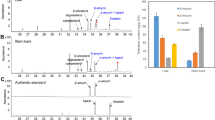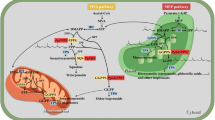Abstract
Main conclusion
An oxidosqualene cyclase (PdFRS) from Populus davidiana was characterized as a monofunctional friedelin synthase by its heterologous expression in yeast and overexpression in plants.
Triterpenes are one of the largest classes of plant chemical compounds composed of three terpene units, which form the basic skeleton of all sterols and saponins. Friedelin (friedelan-3-one), a pentacyclic triterpene, occurs in many plant families and is particularly present in rich amounts in cork tissues from trees. The biosynthesis of friedelin occurs through the oxidosqualene cyclase (OSC) enzyme that generates friedelin from 2,3-oxidosqualene after the maximum rearrangement of a triterpene skeleton. Populus davidiana is called Korean aspen and grows in northern East Asia. From 57,322 unique sequences generated from the P. davidiana transcriptome database, one complete coding sequence (PdFRS) was obtained from a contig, which showed 74% identity to Betula platyphylla β-amyrin synthase and 73% identity with friedelin synthase from Maytenus ilicifolia. The open reading frame (ORF) region of the PdFRS sequence was 2280 bp long and composed a 759 amino acid protein with a predicted molecular mass of 87.81 kDa. qPCR analysis revealed that methyl jasmonate treatments strongly upregulated PdFRS gene expression and resulted in enhanced friedelin accumulation in leaves. Heterologous expression of the PdFRS gene in yeast resulted in the production of friedelin triterpene as a single product, which was confirmed by comparison with the mass fragmentation pattern from an authentic friedelin standard by GC/MS analysis. Transgenic P. davidiana overexpressing the PdFRS gene was constructed via Agrobacterium-mediated transformation. Overexpression of PdFRS in transgenic P. davidiana lines resulted in enhanced friedelin production.









Similar content being viewed by others
Abbreviations
- GC/MS:
-
Gas chromatography–mass spectrometry
- OSC:
-
Oxidosqualene cyclase
- ORF:
-
Open reading frame
- PdFRS:
-
Populus davidiana friedelin synthase gene
- qPCR:
-
Quantitative polymerase chain reaction
- RT-PCR:
-
Reverse transcription-polymerase chain reaction
References
Abramovitch RA, Micetic RG (1963) Extractives from Populus tremuloides heartwood the triterpene alcohols. Can J Chem 41:2362–2367
Alarcón AB, Cuesta-Rubio O, Pérez JC, Piccinelli AL, Rastrelli L (2008) Constituents of the Cuban endemic species Calophyllum pinetorum. J Nat Prod 71:1283–1286
Alves TB, Souza-Moreira TM, Valentini SR, Zanelli CF, Furlan M (2018) Friedelin in Maytenus ilicifolia is produced by friedelin synthase isoforms. Molecules 23:700
Antonisamy P, Duraipandiyan V, Ignacimuthu S (2011) Anti-inflammatory, analgesic and antipyretic effects of friedelin isolated from Azima tetracantha Lam. in mouse and rat models. J Pharm Pharmacol 63:1070–1077
Antonisamy P, Duraipandiyan V, Aravinthan A, Al-Dhabi NA, Ignacimuthu S, Choi KC, Kim JH (2015) Protective effects of friedelin isolated from Azima tetracantha Lam. against ethanol-induced gastric ulcer in rats and possible underlying mechanisms. Eur J Pharmacol 750:167–175
Baldwin IT (1998) Jasmonate-induced responses are costly but benefit plants under attack in native populations. Proc Natl Acad Sci USA 95:8113–8118
Castola V, Marongiu B, Bighelli A, Floris C, Laı̈ A, Casanova J (2005) Extractives of cork (Quercus suber L.): chemical composition of dichloromethane and supercritical CO2 extracts. Ind Crops Prod 21:65–69
Chandler RF, Hooper SN (1979) Friedelin and associated triterpenoids. Phytochemistry 18:711–724
Chen ZN, Xu PJ (1990) Studies on triterpenoids of Populus yunnanensis Dode. Acta Pharm Sin 25:307–310
Cheong JJ, Choi YD (2003) Methyl jasmonate as a vital substance in plants. Trends Genet 19:409–413
Corsino J, de Carvalho PR, Kato MJ, Latorre LR, Oliveira OM, Araújo AR, Bolzani VD, França SC, Pereira AM, Furlan M (2000) Biosynthesis of friedelane and quinonemethide triterpenoids is compartmentalized in Maytenus aquifolium and Salacia campestris. Phytochemistry 55:741–748
Dong HY, Kong CH, Wang P, Huang QL (2014) Temporal variation of soil friedelin and microbial community under different land uses in a long-term agroecosystem. Soil Biol Biochem 69:275–281
El-Shazly A, El-Sayed A, Fikrey E (2012) Bioactive secondary metabolites from Salix tetrasperma Roxb. Z Naturforsch C 67:353–359
Felsenstein J (1985) Confidence limits on phylogenies: an approach using the bootstrap. Evolution 39:783–791
Fernandez MP, Watson PA, Breuil C (2001) Gas chromatography–mass spectrometry method for the simultaneous determination of wood extractive compounds in quaking aspen. J Chromatogr A 922:225–233
Ghosh P, Mandala A, Chakrabortya M, Sahab A (2010) Triterpenoids from Quercus suber and their antimicrobial and phytotoxic activities. J Chem Pharm Res 2:714–721
González-Coloma A, López-Balboa C, Santana O, Reina M, Fraga BM (2011) Triterpene-based plant defenses. Phytochem Rev 10:245–260
Han JY, Kwon YS, Yang DC, Jung YR, Choi YE (2006) Expression and RNA interference-induced silencing of the dammarenediol synthase gene in Panax ginseng. Plant Cell Physiol 47:1653–1662
Karst F, Lacroute F (1977) Ergosterol biosynthesis in Saccharomyces cerevisiae. Mol Gen Genet MGG 154:269–277
Kong CH, Chen LC, Xu XH, Wang P, Wang SL (2008) Allelochemicals and activities in a replanted Chinese fir (Cunninghamia lanceolata (Lamb.) Hook) tree ecosystem. J Agric Food Chem 56:11734–11739
Koo Y, Yeo J, Woo K, Kim T (2007) Selection of superior clones by stability analysis of growth performance in Populus davidiana Dode at age 12. Silvae Genet 56:93–100
Kuete V, Dongfack MDJ, Mbaveng AT, Lallemand MC, Van-Dufat HT, Wansi JD, Seguin E, Tillequin F, Wandji J (2010) Antimicrobial activity of the methanolic extract and compounds from the stem bark of Drypetes tessmanniana. Chin J Integr Med 16:337–343
Le Guilloux V, Schmidtke P, Tuffery P (2009) Fpocket: an open source platform for ligand pocket detection. BMC Bioinform 10:168
Lee KM, Kim YY, Hyun JO (2011) Genetic variation in populations of Populus davidiana Dode based on microsatellite marker analysis. Genes Genom 33:163–171
Li S, Zhen C, Xu W, Wang C, Cheng Y (2017) Simple, rapid and efficient transformation of genotype Nisqually-1: a basic tool for the first sequenced model tree. Sci Rep 7:2638
Livak KJ, Schmittgen TD (2001) Analysis of relative gene expression data using real-time quantitative PCR and the 2−ΔΔC T method. Methods 25:402–408
Lloyd G, Mccown B (1980) Commercially-feasible micropropagation of mountain laurel, Kalmia latifolia, by use of shoot-tip culture. Comb Proc (International Plant Propagators’ Society) 30:421–427
Mann A, Ibrahim K, Oyewale AO, Amupitan JO, Fatope MO, Okogun JI (2011) Antimycobacterial friedelane-terpenoid from the root bark of Terminalia avicennioides. Am J Chem 1:52–55
Manoharan KP, Benny TKH, Yang D (2005) Cycloartane type triterpenoids from the rhizomes of Polygonum bistorta. Phytochemistry 66:2304–2308
Moiteiro C, Marcelo Curto MJ, Mohamed N, Bailén M, Martínez-Díaz R, González-Coloma A (2006) Biovalorization of friedelane triterpenes derived from cork processing industry byproducts. J Agric Food Chem 54:3566–3571
Mokoka TA, Mcgaw LJ, Mdee LK, Bagla VP, Iwalewa EO, Eloff JN (2013) Antimicrobial activity and cytotoxicity of triterpenes isolated from leaves of Maytenus undata (Celastraceae). BMC Complement Altern Med 13:111
Namdeo A (2007) Plant cell elicitation for production of secondary metabolites: a review. Pharmacogn Rev 1:69–79
Nes WD, Heftmann E (1981) A comparison of triterpenoids with steroids as membrane components. J Natl Prod 44:377–400
Nordby HE, Mcdonald RE (1994) Friedelin, the major component of grapefruit epicuticular wax. J Agric Food Chem 42:708–713
Noufou O, Wamtinga SR, André T, Christine B, Marius L, Emmanuelle HA, Jean K, Marie-Geneviève D, Pierre GI (2012) Pharmacological properties and related constituents of stem bark of Pterocarpus erinaceus Poir. (Fabaceae). Asian Pac J Trop Med 5:46–51
Park SB, Kim JY, Han JY, Ahn CH, Park EJ, Choi YE (2017) Exploring genes involved in benzoic acid biosynthesis in the Populus davidiana transcriptome and their transcriptional activity upon methyl jasmonate treatment. J Chem Ecol 43:1097–1108
Parveen M, Mehdi SH, Ghalib RM, Alam M, Hashim R, Sulaiman O (2010) Synthesis, characterization and antimicrobial activity of friedelin [2, 3-d] selenadiazole. Indones J Chem 9:285–288
Pretto JB, Cechinel-Filho V, Noldin VF, Sartori MR, Isaias DE, Cruz AB (2004) Antimicrobial activity of fractions and compounds from Calophyllum brasiliense (Clusiaceae/Guttiferae). Z Naturforsch C 59:657–662
Queiroga CL, Silva GF, Dias PCC, Possenti A, De Carvalho JE (2000) Evaluation of the antiulcerogenic activity of friedelan-3β-ol and friedelin isolated from Maytenus ilicifolia (Celastraceae). J Ethnopharmacol 72:465–468
Roshchin VI, Poverinova OY, Raldugin VA, Pentegova VA (1986) Triterpene alcohols from the leaves of Populus tremula. Chem Nat Compd 22:487
Sainsbury M (1970) Friedelin and epifriedelinol from the bark of Prunus turfosa and a review of their natural distribution. Phytochemistry 9:2209–2215
Santos LS, Santos JCL, Souza Filho APS, Corrêa MJC, Veiga TAM, Freitas VCM, Ferreira ICS, Gonçalves NS, Silva CE, Guilhon GMSP (2008) Allelopathic activity of chemical substances isolated from Brachiaria brizantha cv. Marandu and their variations in function of pH (in portuguese). Planta Daninha 26:531–538
Slatkin DJ, Doorenbos NJ, Harris LS, Masoud AN, Quimby MW, Schiff PL (1971) Chemical constituents of Cannabis sativa L. root. J Pharm Sci 60:1891–1892
Souza-Moreira TM, Alves TB, Pinheiro KA, Felippe LG, De Lima GMA, Watanabe TF, Barbosa CC, Santos VAFFM, Lopes NP, Valentini SR, Guido RVC, Furlan M, Zanelli CF (2016) Friedelin synthase from Maytenus ilicifolia: leucine 482 plays an essential role in the production of the most rearranged pentacyclic triterpene. Sci Rep 6:36858
Subhadhirasakul S, Pechpongs P (2005) A terpenoid and two steroids from the flowers of Mammea siamensis. Songklanakarin J Sci Technol 27:555–561
Sunil C, Duraipandiyan V, Ignacimuthu S, Al-Dhabi NA (2013) Antioxidant, free radical scavenging and liver protective effects of friedelin isolated from Azima tetracantha Lam. leaves. Food Chem 139:860–865
Szakiel A, Niżyński B, Pączkowski C (2013) Triterpenoid profile of flower and leaf cuticular waxes of heather Calluna vulgaris. Nat Prod Res 27:1404–1407
Tamokou JDD, Tala MF, Wabo HK, Kuiate JR, Tane P (2009) Antimicrobial activities of methanol extract and compounds from stem bark of Vismia rubescens. J Ethnopharmacol 124:571–575
Tamura K, Stecher G, Peterson D, Filipski A, Kumar S (2013) MEGA6: molecular evolutionary genetics analysis version 6.0. Mol Biol Evol 30:2725–2729
Tchakam PD, Lunga PK, Kowa TK, Lonfouo AHN, Wabo HK, Tapondjou LA, Tane P, Kuiate JR (2012) Antimicrobial and antioxidant activities of the extracts and compounds from the leaves of Psorospermum aurantiacum Engl. and Hypericum lanceolatum Lam. BMC Complement Altern Med 12:136
Thimmappa R, Geisler K, Louveau T, O’maille P, Osbourn A (2014) Triterpene biosynthesis in plants. Annu Rev Plant Biol 65:225–257
Van Maarseveen C, Jetter R (2009) Composition of the epicuticular and intracuticular wax layers on Kalanchoe daigremontiana (Hamet et Perr. de la Bathie) leaves. Phytochemistry 70:899–906
Wang Z, Yeats T, Han H, Jetter R (2010) Cloning and characterization of oxidosqualene cyclases from Kalanchoe daigremontiana: enzymes catalyzing up to 10 rearrangement steps yielding friedelin and other triterpenoids. J Biol Chem 285:29703–29712
Wenzel DG, Emick GH (1956) An investigation of triterpenes as steroid hormones. J Am Pharm Assoc 45:284–287
Xu R, Fazio GC, Matsuda SPT (2004) On the origins of triterpenoid skeletal diversity. Phytochemistry 65:261–291
Xu C, Qin M, Fu Y, Liu N, Hemming J, Holmbom B, Willförd S (2010) Lipophilic extractives in Populus x euramericana “Guariento” stemwood and bark. J Wood Chem Technol 30:105–117
Acknowledgements
This work was supported by the Rural Development Administration, Republic of Korea [Next-Generation Bio-Green 21 Program (PJ01344401 and PJ01369103)].
Author information
Authors and Affiliations
Corresponding author
Ethics declarations
Conflict of interest
The authors declare that they have no conflicts of interest.
Rights and permissions
About this article
Cite this article
Han, J.Y., Ahn, CH., Adhikari, P.B. et al. Functional characterization of an oxidosqualene cyclase (PdFRS) encoding a monofunctional friedelin synthase in Populus davidiana. Planta 249, 95–111 (2019). https://doi.org/10.1007/s00425-018-2985-8
Received:
Accepted:
Published:
Issue Date:
DOI: https://doi.org/10.1007/s00425-018-2985-8




